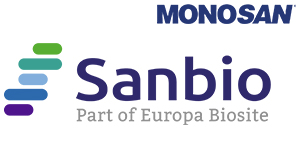Mouse anti-TLR9, clone 5G5 (Monoclonal)
Mouse anti-TLR9, clone 5G5 (Monoclonal)
SKU
SANMON2093
Packaging Unit
1 ml
Manufacturer
Sanbio / Monosan
Availability:
loading...
Price is loading...
Clone Number: 5G5
Immunogen: Unknown or proprietery to MONOSAN and/or its suppliers
Concentration: 100 ug/ ml
Storage buffer: PBS with 0.1% BSA and 0.02% sodium azide
Additional info: The monoclonal antibody 5G5 recognizes human Toll-like receptor 9. Toll-like receptors (TLRs) are highly conserved from Drosophila to humans and share structural and functional similarities. TLRs constitute of a family of pattern recognition receptors (PRRs) that mediate cellular responses to a large variety of pathogens (viruses, bacteria, and parasites) by specific recognition of so-called ‘pathogen-associated molecular patterns’. Activation of TLRs, a family of at least 11 differentmembers that function either as homo- or heterodimers, leads to activation of NFκB-dependent and IFNregulatory factor-dependent signaling pathways. TLRs have a central role in innate immunity and are also required for the development of an adaptive immune response. TLRs are expressed by various cells of the immune system, such as macrophages and dendritic cells. They recognize and respond to molecules derived from bacterial, viral and fungal pathogens.
Whereas most TLRs are expressed on the cell surface, TLR9 is expressed intracellularly within one or more endosomal compartments and recognizes nucleic acids. TLR9 detects a rather subtle difference in the DNA of vertebrates compared with that of pathogens. Vertebrate genomic DNAs have mostly methylated CpG dinucleotides where bacterial and viral DNAs have unmethylated CpG dinucleotides. TLR9 undergoes relocation from endoplasmic reticulum to CpG-ODN-containing endosomes. In these endosomes TLR9 becomes a functional receptor after proteolytic cleavage. TLR9 exists as a preformed homodimer and CpG-ODN binding promotes its conformational change, bringing the cytoplasmic TIR-like domains close to each other. This allows a recruitment of the key adapter protein MyD88 which initiates a signalling cascade. The only human immune cell types known to constitutively express TLR9 and to be activated by CpG ODN are pDCs and B cells. TLR9 triggering induces an activation phenotype in the B cells and pDCs, characterized by the expression of costimulatory molecules, resistance to apoptosis, and induces Th1-type immune response profiles.
References: Ahmad-Nejad; P et al. Eur J Immunol 2002; 32: 1958/Rutz, M et al Eur J Immunol 2004, 34: 2541/Rumio C et al. Am J Pathol 2004; 165:373
Immunogen: Unknown or proprietery to MONOSAN and/or its suppliers
Concentration: 100 ug/ ml
Storage buffer: PBS with 0.1% BSA and 0.02% sodium azide
Additional info: The monoclonal antibody 5G5 recognizes human Toll-like receptor 9. Toll-like receptors (TLRs) are highly conserved from Drosophila to humans and share structural and functional similarities. TLRs constitute of a family of pattern recognition receptors (PRRs) that mediate cellular responses to a large variety of pathogens (viruses, bacteria, and parasites) by specific recognition of so-called ‘pathogen-associated molecular patterns’. Activation of TLRs, a family of at least 11 differentmembers that function either as homo- or heterodimers, leads to activation of NFκB-dependent and IFNregulatory factor-dependent signaling pathways. TLRs have a central role in innate immunity and are also required for the development of an adaptive immune response. TLRs are expressed by various cells of the immune system, such as macrophages and dendritic cells. They recognize and respond to molecules derived from bacterial, viral and fungal pathogens.
Whereas most TLRs are expressed on the cell surface, TLR9 is expressed intracellularly within one or more endosomal compartments and recognizes nucleic acids. TLR9 detects a rather subtle difference in the DNA of vertebrates compared with that of pathogens. Vertebrate genomic DNAs have mostly methylated CpG dinucleotides where bacterial and viral DNAs have unmethylated CpG dinucleotides. TLR9 undergoes relocation from endoplasmic reticulum to CpG-ODN-containing endosomes. In these endosomes TLR9 becomes a functional receptor after proteolytic cleavage. TLR9 exists as a preformed homodimer and CpG-ODN binding promotes its conformational change, bringing the cytoplasmic TIR-like domains close to each other. This allows a recruitment of the key adapter protein MyD88 which initiates a signalling cascade. The only human immune cell types known to constitutively express TLR9 and to be activated by CpG ODN are pDCs and B cells. TLR9 triggering induces an activation phenotype in the B cells and pDCs, characterized by the expression of costimulatory molecules, resistance to apoptosis, and induces Th1-type immune response profiles.
References: Ahmad-Nejad; P et al. Eur J Immunol 2002; 32: 1958/Rutz, M et al Eur J Immunol 2004, 34: 2541/Rumio C et al. Am J Pathol 2004; 165:373
| SKU | SANMON2093 |
|---|---|
| Manufacturer | Sanbio / Monosan |
| Manufacturer SKU | MON2093 |
| Green Labware | No |
| Package Unit | 1 ml |
| Quantity Unit | STK |
| Reactivity | Human, Mouse (Murine), Dog (Canine) |
| Clonality | Monoclonal |
| Application | Immunofluorescence, Immunohistochemistry (frozen), Immunohistochemistry (paraffin), Western Blotting, Flow Cytometry |
| Isotype | IgG2a |
| Host | Mouse |
| Product information (PDF) | Download |
| MSDS (PDF) |
|

 Deutsch
Deutsch







